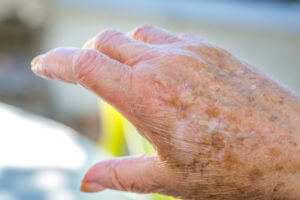Can My Aging Loved One Develop Melanoma?

Home Care in Mobile AL: Melanoma
Aging adults are at a higher risk than most when it comes to developing melanoma. Melanoma is a type of skin cancer that develops in the darkened parts of the skin known as moles. Without treatment, melanoma can spread to the rest of the body. However, early detection and treatment of this common skin cancer usually result in a full recovery. Family caregivers can help identify unusual moles on their aging loved one’s body as part of a regular mole inspection.
How to Recognize Symptoms of Melanoma
Melanoma can occur anywhere on the body, but it usually develops in areas that are regularly exposed to sunlight, such as the shoulders, head, neck, arms and legs. It is also most likely to be found in people with a fair complexion, red or blond hair, freckles and a lot of sun exposure in life. Experts recommend doing a mole inspection at least twice per year, but family caregivers and elder care providers who look after a senior with one or more of those factors should increase frequency of the mole inspections.
A suspicious mole is one that doesn’t fit the typical criteria for healthy pigmented areas on the skin. Moles that are multiple colors or have irregular or bumpy edges should be pointed out to a doctor. Other symptoms include an asymmetrical shape, change in appearance or size, itching or bleeding. In some cases, an existing mole may look typical but suddenly develop new moles near it. Many people adopt the ABCDE guideline for moles.
The ABCDE guideline helps people identify what is typical with moles on the body and what is worth a closer look. The ABCDE method stands for Asymmetry/Border/Color/Diameter/Evolving. It helps family members and elder care providers remember what to look for and what criteria separates common moles and atypical ones. Anything that looks out of the ordinary or has changed from the last mole inspection needs to be pointed out to a doctor.
Treating Melanoma in Aging Adults
When a doctor takes a look at the suspicious mole, they may feel comfortable in saying that it doesn’t appear to be melanoma. However, if they suspect it is, they will generally do a biopsy. A biopsy is when the mole and the surrounding skin is removed and sent to a lab for analysis. Technicians will look at the tissue and determine whether they can identify cancer cells there. What they find out will determine the type of treatment the doctor will call for.
Aging adults struggle to identify suspicious moles on their own, and really do need help from family caregivers and elder care providers. While a mole inspection a few times per year may seem strange or awkward, it’s one of the best ways to spot melanoma. With early detection comes early treatment for aging adults, with plenty of time for a fulfilling and happy future ahead of them.
If you or someone you know needs Home Care in Mobile, AL, please contact the friendly caregivers at Hughes Home Care. We provide quality and affordable care for your elderly loved ones in our community. Call Us Today 251-517-9901. Serving Mobile & Baldwin County.
- The Best Things Seniors Can Do To Avoid Skin Cancer - April 18, 2024
- Ways to Make Walking More Exciting - April 4, 2024
- What Causes Your Senior to Feel Fatigue? - March 22, 2024
